Oscillation of Cavitating Vortices in Draft Tubes of a Simplified Model Turbine and a Model Pump–Turbine †
Abstract
:1. Introduction
2. Experimental Setup and Techniques
2.1. Simplified Draft Tube Model
2.2. Model Pump–Turbine
3. Results and Analysis
3.1. Characteristics of ST
3.2. Characteristics of PT
4. Theoretical Approach
4.1. Basic Principle
4.2. Pressure Distribution Calculation behind the Runner
4.3. Simulation of the Cavity Oscillations
5. Conclusions
Author Contributions
Funding
Institutional Review Board Statement
Informed Consent Statement
Data Availability Statement
Conflicts of Interest
References
- Favrel, A.; Müller, A.; Landry, C.; Yamamoto, K.; Avellan, F. LDV survey of cavitation and resonance effect on the precessing vortex rope dynamics in the draft tube of Francis turbines. Exp. Fluids 2016, 57, 168. [Google Scholar] [CrossRef]
- Lu, G.; Zuo, Z.; Sun, Y.; Liu, D.; Tsujimoto, Y.; Liu, S. Experimental evidence of cavitation influences on the positive slope on the pump performance curve of a low specific speed model pump-turbine. Renew. Energy 2017, 113, 1539–1550. [Google Scholar] [CrossRef]
- Alligne, S.; Nicolet, C.; Tsujimoto, Y.; Avellan, F. Cavitation surge modelling in Francis turbine draft tube. J. Hydraul. Res. 2014, 52, 399–411. [Google Scholar] [CrossRef]
- Li, D.; Sun, Y.; Zuo, Z.; Liu, S.; Wang, H.; Li, Z. Analysis of Pressure Fluctuations in a Prototype Pump-Turbine with Different Numbers of Runner Blades in Turbine Mode. Energies 2018, 11, 1474. [Google Scholar] [CrossRef] [Green Version]
- Rheingans, W.J. Power swings in hydroelectric power plants. Trans. ASME 1940, 62, 171–184. [Google Scholar]
- Valentín, D.; Presas, A.; Egusquiza, E.; Valero, C.; Egusquiza, M.; Bossio, M. Power Swing Generated in Francis Turbines by Part Load and Overload Instabilities. Energies 2017, 10, 2124. [Google Scholar] [CrossRef] [Green Version]
- Müller, A.; Favrel, A.; Landry, C.; Yamamoto, K.; Avellan, F. Experimental Hydro-Mechanical Characterization of Full Load Pressure Surge in Francis Turbines. J. Phys. Conf. Ser. 2017, 813, 12018. [Google Scholar] [CrossRef] [Green Version]
- Braisted, D.M.; Brennen, C.E. Auto-Oscillation of Cavitating Inducers. In Proceedings of the Polyphase Flow and Transport Technology, San Francisco, CA, USA, 13–15 August 1980; pp. 157–166. [Google Scholar]
- Nishi, M.; Kubota, T.; Matsunaga, S.; Senoo, Y. Study on swirl flow and surge in an elbow type draft tube. In Proceedings of the 10th IAHR Symposium on Hydraulic Machinery and Cavitation, Tokyo, Japan, 9–11 September 1980; Volume 1, p. 557. [Google Scholar]
- Tsujimoto, Y.; Kamijo, K.; Yoshida, Y. Theoretical analysis of rotating cavitation in rocket pump inducers. In Proceedings of the 28th Joint Propulsion Conference and Exhibit, Nashville, TN, USA, 6–8 July 1992; American Institute of Aeronautics and Astronautics: Reston, VA, USA, 1992; Volume 115, pp. 135–141. [Google Scholar]
- Otsuka, S.; Tsujimoto, Y.; Kamijo, K.; Furuya, O. Frequency Dependence of Mass Flow Gain Factor and Cavitation Compliance of Cavitating Inducers. J. Fluids Eng. 1996, 118, 400–408. [Google Scholar] [CrossRef]
- Streeter, V.L. Transient Cavitating Pipe Flow. J. Hydraul. Eng. 1983, 109, 1407–1423. [Google Scholar] [CrossRef]
- Chen, C.; Nicolet, C.; Yonezawa, K.; Farhat, M.; Avellan, F.; Tsujimoto, Y. One-Dimensional Analysis of Full Load Draft Tube Surge. J. Fluids Eng. 2008, 130, 041106. [Google Scholar] [CrossRef]
- Kuibin, P.A.; Pylev, I.M.; Zakharov, A.V. Two-phase models development for description of vortex-induced pulsation in Francis turbine. IOP Conf. Ser. Earth Environ. Sci. 2012, 15, 022001. [Google Scholar] [CrossRef]
- Kuibin, P.A.; Zakharov, A.V. On low-frequency unsteady phenomena caused by cavitation in hydroturbines. IOP Conf. Ser. Earth Environ. Sci. 2019, 288, 012100. [Google Scholar] [CrossRef]
- Müller, A.; Favrel, A.; Landry, C.; Avellan, F. Fluid–structure interaction mechanisms leading to dangerous power swings in Francis turbines at full load. J. Fluids Struct. 2017, 69, 56–71. [Google Scholar] [CrossRef]
- Müller, A.; Favrel, A.; Landry, C.; Yamamoto, K.; Avellan, F. On the physical mechanisms governing self-excited pressure surge in Francis turbines. IOP Conf. Ser. Earth Environ. Sci. 2014, 22, 32034. [Google Scholar] [CrossRef] [Green Version]
- Müller, A.; Yamamoto, K.; Alligné, S.; Yonezawa, K.; Tsujimoto, Y.; Avellan, F. Measurement of the Self-Oscillating Vortex Rope Dynamics for Hydroacoustic Stability Analysis. J. Fluids Eng. 2015, 138, 021206. [Google Scholar] [CrossRef]
- Skripkin, S.; Tsoy, M.; Kuibin, P.; Shtork, S. Swirling flow in a hydraulic turbine discharge cone at different speeds and discharge conditions. Exp. Therm. Fluid Sci. 2019, 100, 349–359. [Google Scholar] [CrossRef]
- Li, D.; Chang, H.; Zuo, Z.; Wang, H.; Li, Z.; Wei, X. Experimental investigation of hysteresis on pump performance characteristics of a model pump-turbine with different guide vane openings. Renew. Energy 2020, 149, 652–663. [Google Scholar] [CrossRef]
- Szakal, R.-A.; Doman, A.; Muntean, S. Influence of the Reshaped Elbow on the Unsteady Pressure Field in a Simplified Geometry of the Draft Tube. Energies 2021, 14, 1393. [Google Scholar] [CrossRef]
- Bosioc, A.I.; Susan-Resiga, R.; Muntean, S.; Tanasa, C. Unsteady Pressure Analysis of a Swirling Flow With Vortex Rope and Axial Water Injection in a Discharge Cone. J. Fluids Eng. 2012, 134, 081104. [Google Scholar] [CrossRef]
- Urban, O.; Kurková, M.; Rudolf, P. Application of Computer Graphics Flow Visualization Methods in Vortex Rope Investigations. Energies 2021, 14, 623. [Google Scholar] [CrossRef]
- Skripkin, S.G.; Tsoy, M.A.; Kuibin, P.A.; Zuo, Z.; Liu, S. High speed visualization of self-oscillation of axisymmetric cavitating cavity in a square vortex chamber. J. Phys. Conf. Ser. 2019, 1421, 012029. [Google Scholar] [CrossRef] [Green Version]
- IEC 60193-6; Hydraulic Turbines, Storage Pumps and Pump-Turbines; International Commission: Geneva, Switzerland, 1999.
- Favrel, A.; Gomes Pereira Junior, J.; Landry, C.; Müller, A.; Nicolet, C.; Avellan, F. New insight in Francis turbine cavitation vortex rope: Role of the runner outlet flow swirl number. J. Hydraul. Res. 2018, 56, 367–379. [Google Scholar] [CrossRef]
- Otsu, N. A Threshold Selection Method from Gray-Level Histograms. IEEE Trans. Syst. Man. Cybern. 1979, 9, 62–66. [Google Scholar] [CrossRef] [Green Version]
- Khozaei, M.H.; Favrel, A.; Miyagawa, K. On the generation mechanisms of low-frequency synchronous pressure pulsations in a simplified draft-tube cone. Int. J. Heat Fluid Flow 2022, 93, 8912. [Google Scholar] [CrossRef]
- Sirovich, L. Turbulence and the dynamics of coherent structures. I. Coherent structures. Q. Appl. Math. 1987, 45, 561–571. [Google Scholar] [CrossRef] [Green Version]
- Danlos, A.; Ravelet, F.; Coutier-Delgosha, O.; Bakir, F. Cavitation regime detection through Proper Orthogonal Decomposition: Dynamics analysis of the sheet cavity on a grooved convergent-divergent nozzle. Int. J. Heat Fluid Flow 2014, 47, 9–20. [Google Scholar] [CrossRef] [Green Version]
- Kuibin, P.; Okulov, V. One-dimensional solutions for a flow with a helical symmetry. Thermophys. Aeromechanics 1996, 3, 335–339. [Google Scholar]
- Alekseenko, S.V.; Kuibin, P.A.; Okulov, V.L.; Shtork, S.I. Helical vortices in swirl flow. J. Fluid Mech. 1999, 382, 195–243. [Google Scholar] [CrossRef]
- Alekseenko, S.V.; Kuibin, P.A.; Okulov, V.L. Theory of Concentrated Vortices: An Introduction; Springer: Berlin/Heidelberg, Germany, 2007; ISBN 9783540733751. [Google Scholar]

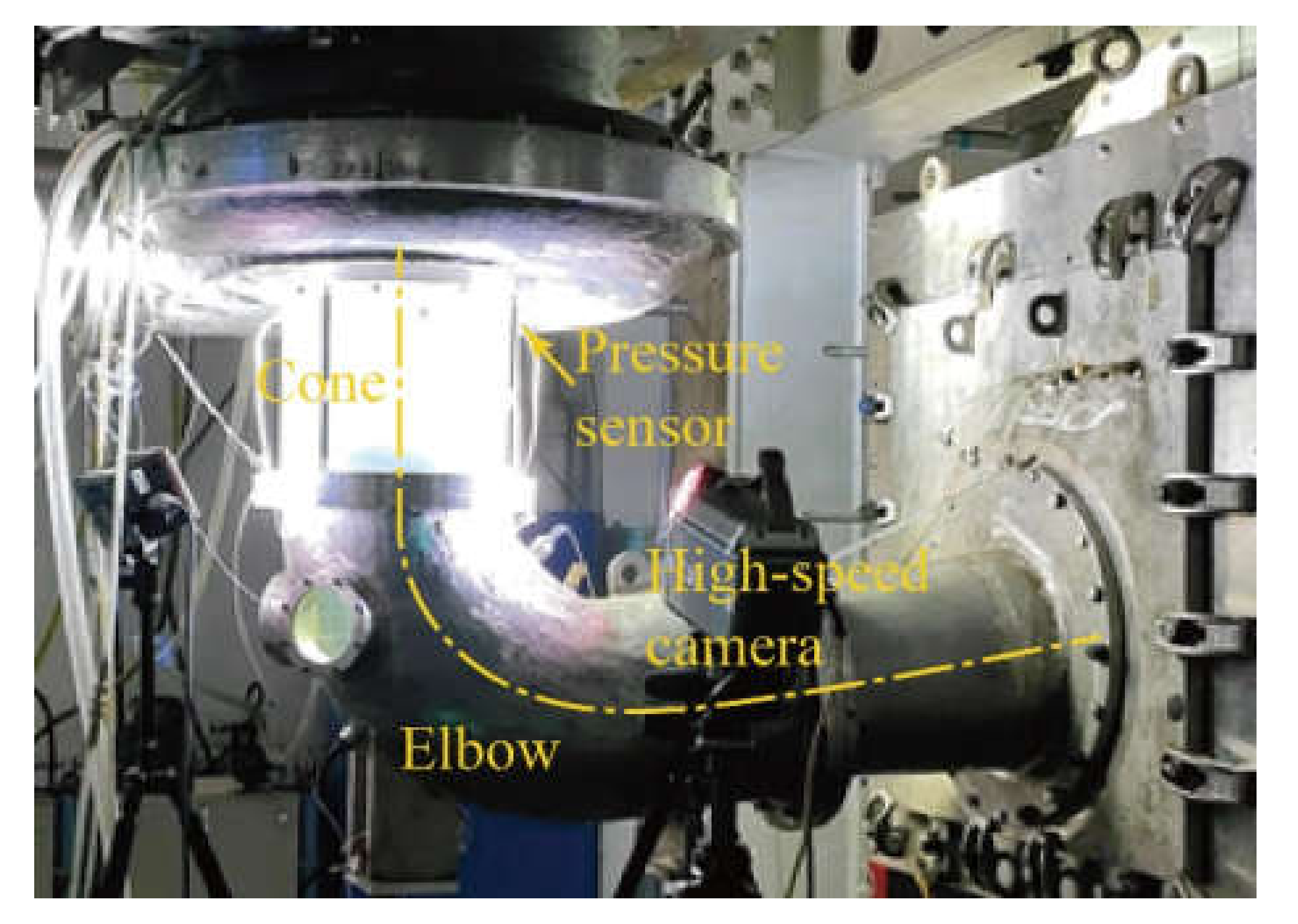

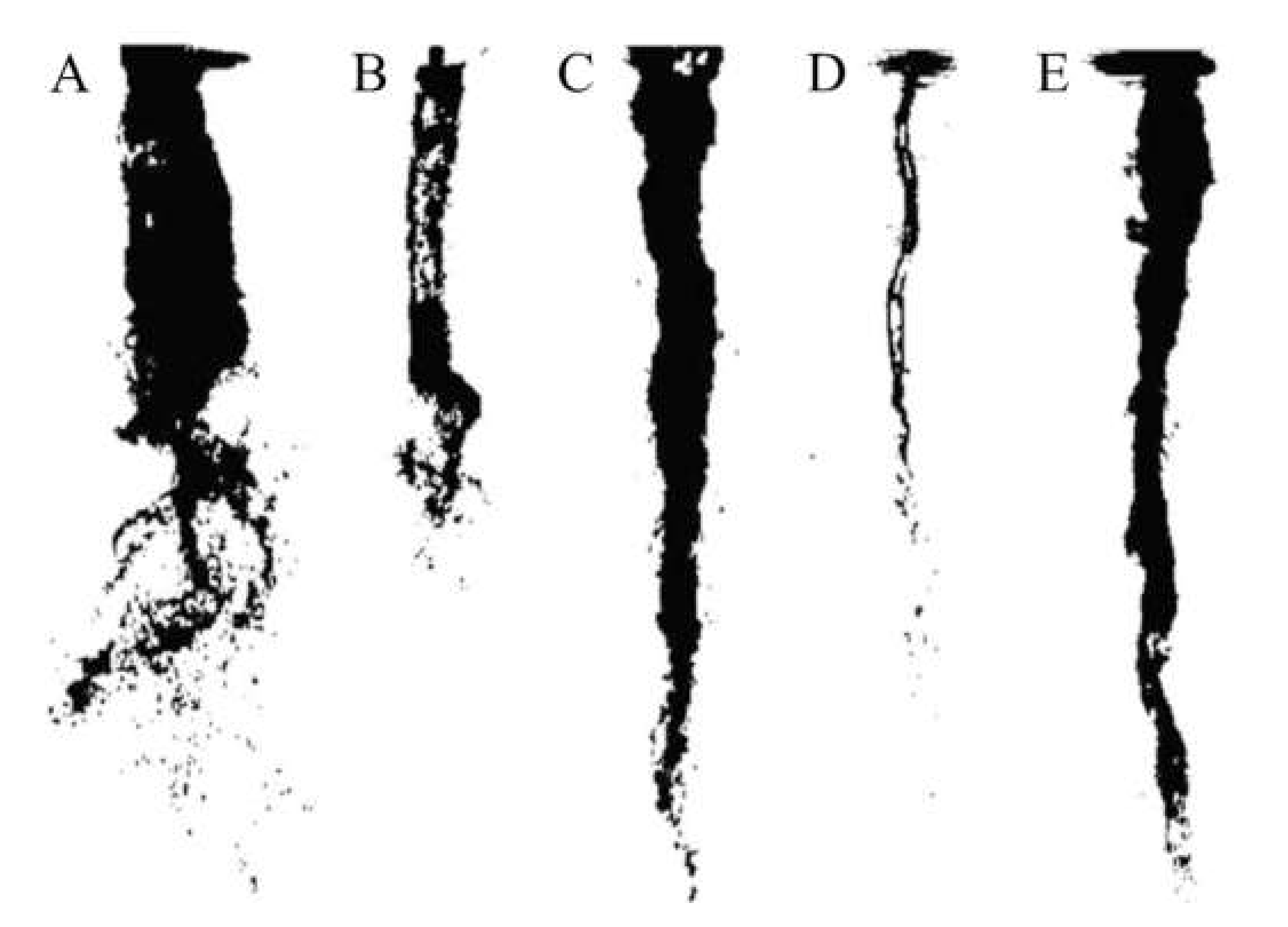

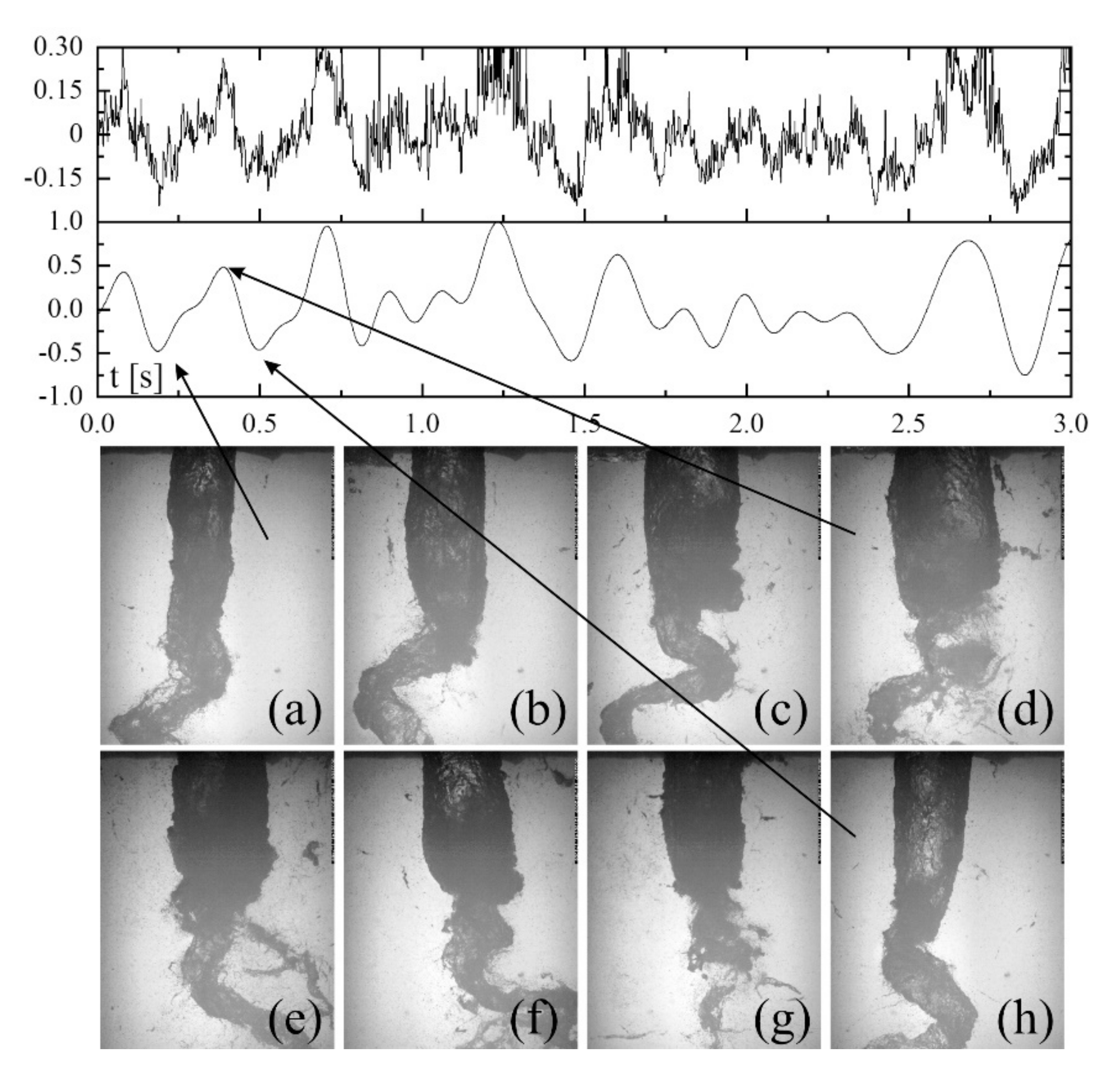
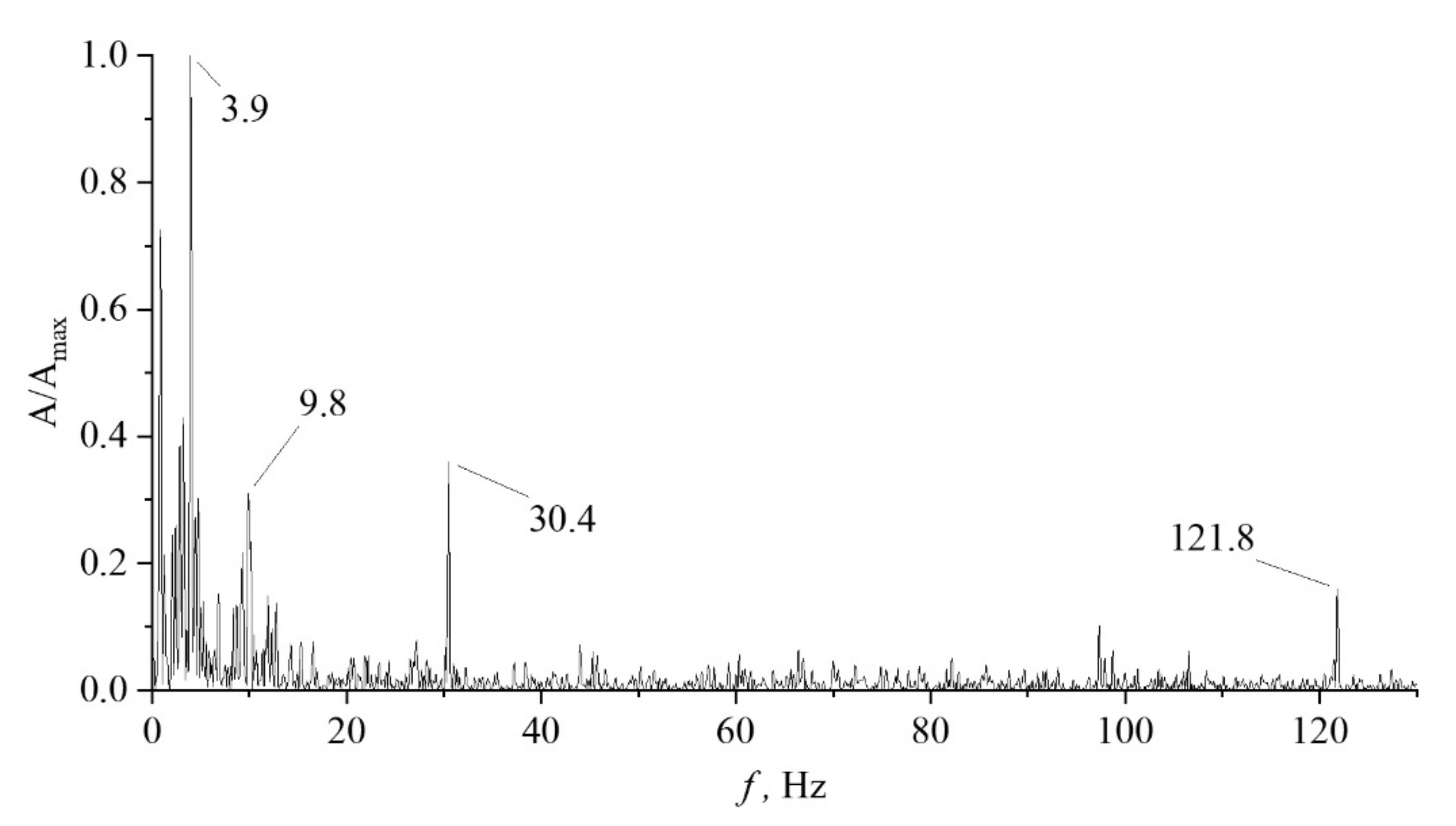






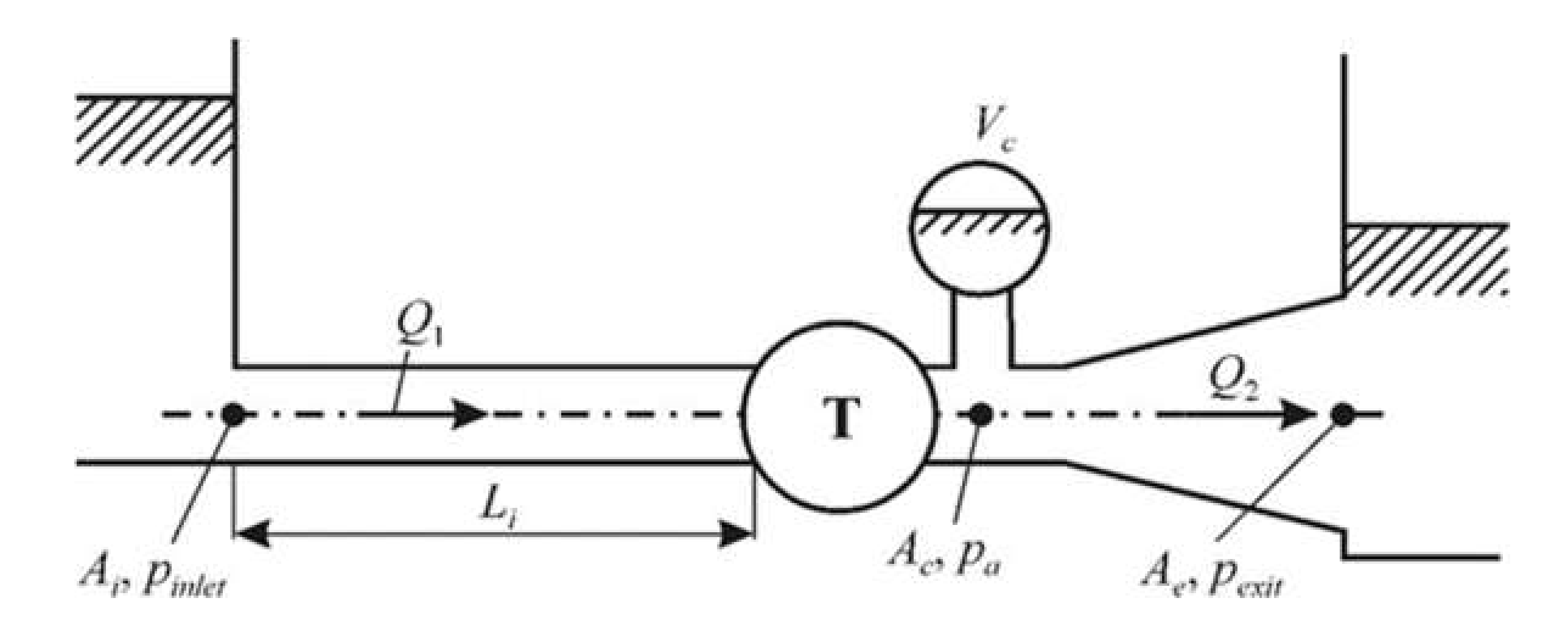


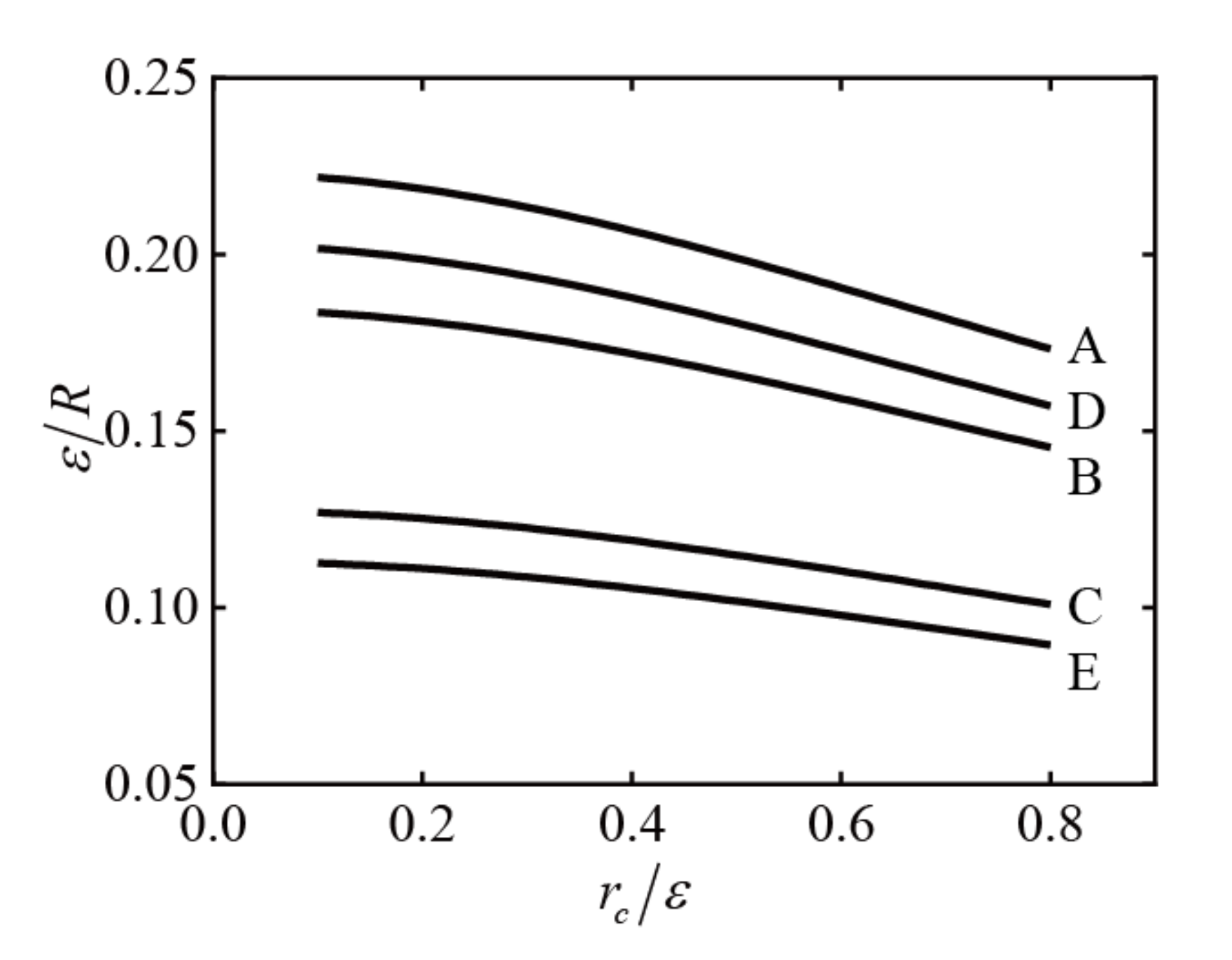
| Condition No. | n (r/min) | Q (m3/s) | dp (kPa) |
|---|---|---|---|
| 1 | 860 | 0.031 | −33 |
| 2 | 860 | 0.031 | −57 |
| 3 | 860 | 0.031 | −83 |
| 4 | 890 | 0.031 | −83 |
| 5 | 910 | 0.031 | −83 |
| Parameter | Value |
|---|---|
| ) | 400 mm |
| ) | 299 mm |
| ) | 7 |
| ) | 20 |
| Condition No. | n11 (r/s) | Q11 (m3/s) | Guide Vane Opening (°) | S | Main Frequency (Hz) |
|---|---|---|---|---|---|
| A | 1.20 | 0.735 | 23.6 | 0.272 | 5.125 |
| B | 1.14 | 0.702 | 21.9 | 0.156 | 5.75 |
| C | 1.13 | 0.868 | 30 | −0.237 | 5.0 |
| D | 1.00 | 0.642 | 18.4 | −0.242 | 5.0 |
| E | 1.00 | 0.765 | 23.6 | −0.551 | 5.5 |
Publisher’s Note: MDPI stays neutral with regard to jurisdictional claims in published maps and institutional affiliations. |
© 2022 by the authors. Licensee MDPI, Basel, Switzerland. This article is an open access article distributed under the terms and conditions of the Creative Commons Attribution (CC BY) license (https://creativecommons.org/licenses/by/4.0/).
Share and Cite
Skripkin, S.; Zuo, Z.; Tsoy, M.; Kuibin, P.; Liu, S. Oscillation of Cavitating Vortices in Draft Tubes of a Simplified Model Turbine and a Model Pump–Turbine. Energies 2022, 15, 2965. https://doi.org/10.3390/en15082965
Skripkin S, Zuo Z, Tsoy M, Kuibin P, Liu S. Oscillation of Cavitating Vortices in Draft Tubes of a Simplified Model Turbine and a Model Pump–Turbine. Energies. 2022; 15(8):2965. https://doi.org/10.3390/en15082965
Chicago/Turabian StyleSkripkin, Sergey, Zhigang Zuo, Mikhail Tsoy, Pavel Kuibin, and Shuhong Liu. 2022. "Oscillation of Cavitating Vortices in Draft Tubes of a Simplified Model Turbine and a Model Pump–Turbine" Energies 15, no. 8: 2965. https://doi.org/10.3390/en15082965
APA StyleSkripkin, S., Zuo, Z., Tsoy, M., Kuibin, P., & Liu, S. (2022). Oscillation of Cavitating Vortices in Draft Tubes of a Simplified Model Turbine and a Model Pump–Turbine. Energies, 15(8), 2965. https://doi.org/10.3390/en15082965







